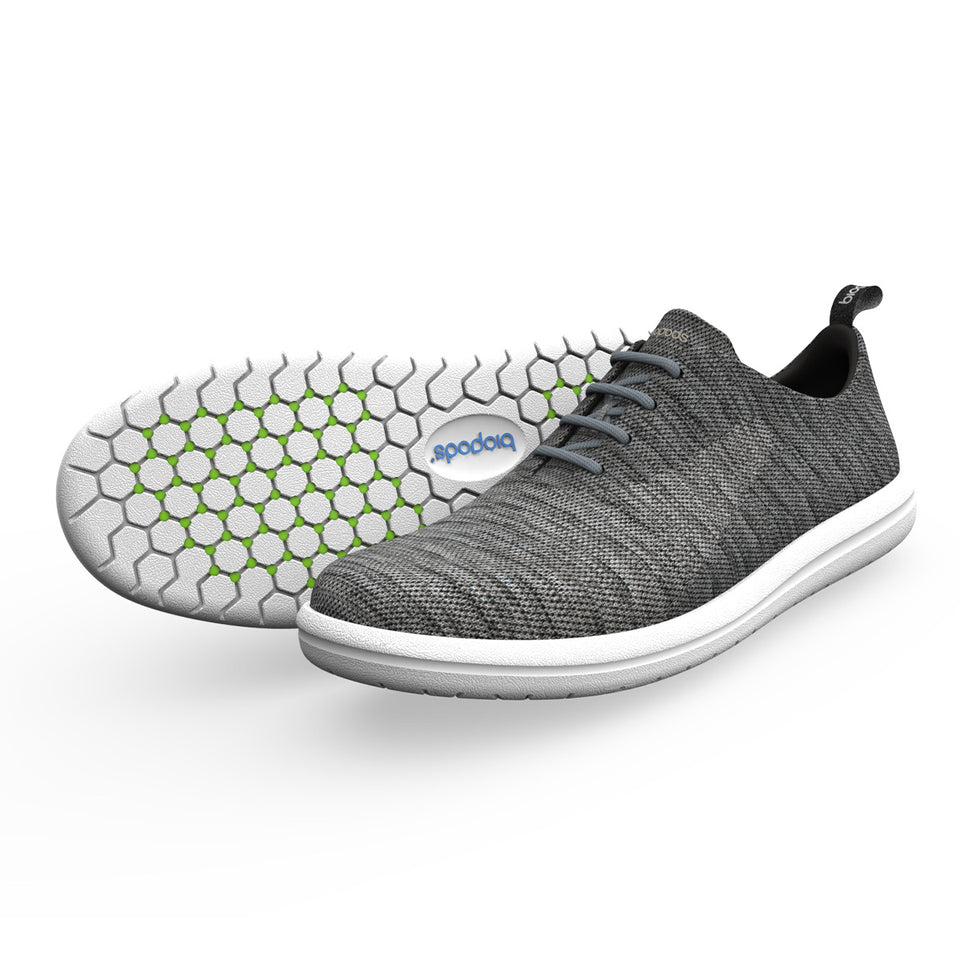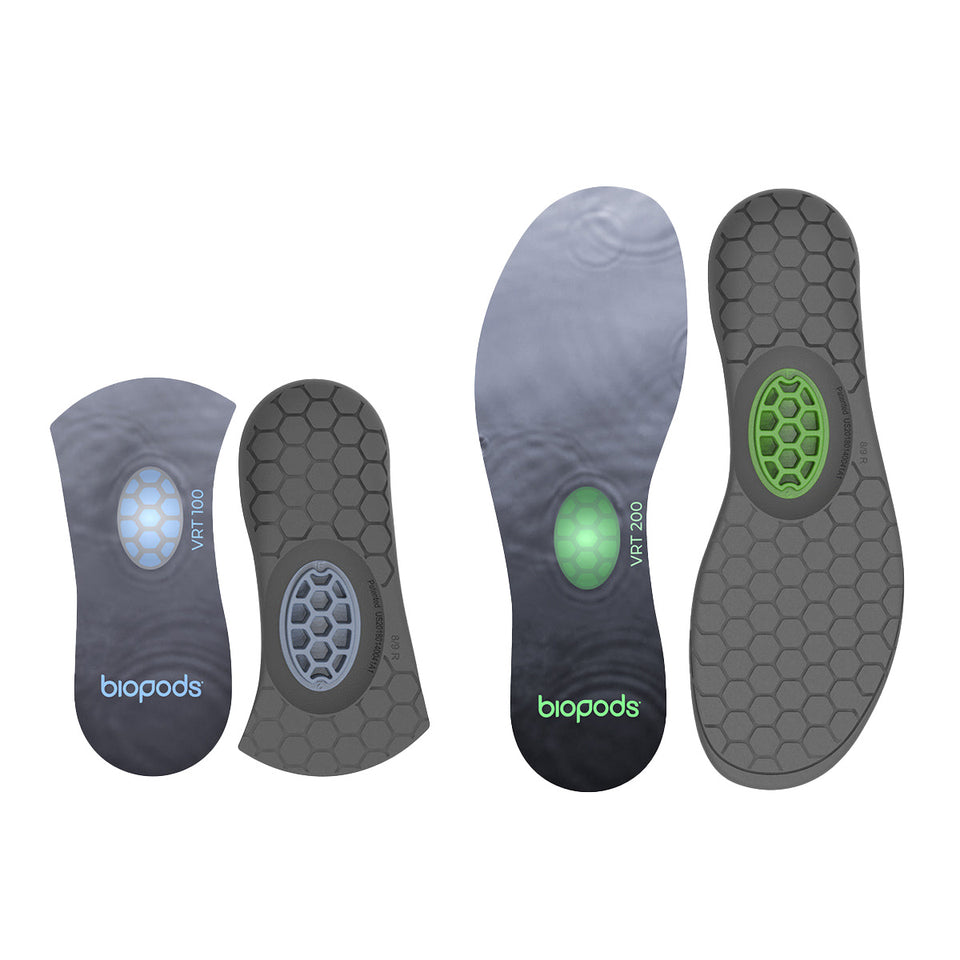Metatarsalgia
The symptoms of Metatarsalgia include pain under the balls of the feet and swelling and inflammation at the heads of the metatarsal bones. (The metatarsal heads form the balls of the feet.)
Dr. Sam Dubé discusses metatarsalgia
Learn about the symptoms, causes, and benefits of different treatment options.
 What causes metatarsalgia?
What causes metatarsalgia?
Poor foot mechanics caused by footwear use is the leading cause of metatarsalgia.
There are three main contributing causes:
-
Wearing footwear that presents a concave surface under the metatarsal heads: In essence, this causes the second, third, and fourth metatarsal heads to drop, significantly increasing the load they bear. The concave supportive surface of the footwear may be a result of footwear design or it may be caused by midsole/insole material breakdown or compression due to long-term use.
-
Long-term use of footwear or insoles that provide excessive cushioning: This causes the body to stop producing robust soft tissue padding under the metatarsal heads, which creates a highly sensitized area.
-
Failure of the foot muscles to correctly align the bones of the feet into strong and dynamically adaptable arches: This leads to foot instability and torsional forces on the metatarsal bones.
These causes can present simultaneously and can worsen the severity of the symptoms and difficulty in eliminating the causes.
Modern science has identified that the nervous system plays a critical role in stabilizing the feet and ankles when walking or running. It is now understood that poor foot function are a symptom of inefficient neuromuscular function caused by conventional footwear use. In fact, conventional footwear use causes poor neuromuscular function throughout the feet, legs, hips, and back, when:
-
the soles of the feet don’t receive the subtle, varied stimulus that the nervous system requires for healthy function,
-
snug toe boxes, stiff midsoles/outsoles/uppers and tight lacing restrict healthy foot movement, and
-
footwear midsoles / outsoles feature a concave supporting surface under the metatarsal heads.
To understand the relationship between footwear and lower limb pathologies, click HERE.
The best way to prevent and treat metatarsalgia is to retrain healthy neuromuscular function and to use footwear that has a flat supporting surface under the metatarsal heads and that is soft, flexible, and roomier in the forefoot.
Conventional treatment methods for metatarsalgia
Since the late 1890s, the standard treatment for poor foot mechanics has been to artificially support the arches with an orthotic. Other conventional treatment options include:
-
Cushioning
-
Ice
Modern science has transitioned away from using long-term support and cushioning on any body part because it causes a progressive weakening of the body part being supported or cushioned.
The modern approach to treating metatarsalgia
Science underscores the body's inherent ability to restore and improve its own function when presented with the appropriate challenges. This principle lies at the heart of contemporary therapeutic methods used to correct and enhance neuromuscular function, particularly in foot health.
Therapeutic rehabilitation, focusing on the body's natural mechanics and responses, emerges as the safest and most effective strategy for addressing the underlying causes of conditions like metatarsalgia, shifting the focus from temporary relief to long-term health and functionality.
Understanding the Fundamentals:
-
Proper Technique: This refers to rehabilitative exercises that concentrate on re-establishing optimal neuromuscular function. It's about reinforcing healthy mobility, muscle strength, stability, and alignment in a safe manner.
-
Right Stimulus and Right Movement: Effective movement is predicated on the quality of sensory information the brain receives, particularly from the soles of the feet. The feet's nerve endings are crucial in transmitting this data, ensuring coordinated movement throughout the musculoskeletal system. When sensory input is compromised—as is often the case with conventional footwear—the body's natural reflexes and movements can be inhibited.
Adopting the Modern Approach:
-
Barefoot Walking: Engage in barefoot walking, particularly on natural surfaces, as frequently as feasible. This practice delivers the optimal stimulus for healthy neuromuscular function, promoting the right kind of movement.
-
Utilization of Biopods®: Incorporate Biopods footwear or insoles into your routine. Our footwear is designed to create an ideal environment for proper foot technique, while our insoles are crafted to enhance the sensory feedback in your conventional shoes. For optimal results, use in footwear that is soft, flexible, and allows for natural movement of the arches and toes.
-
Consultation with Healthcare Professionals: Prior injuries might have led to the formation of fibrotic scar tissue. It's advisable to consult with a healthcare practitioner about therapies that can address these issues to facilitate better foot function.
Conclusion:
The modern approach to foot health is integrative and proactive, focusing on encouraging the body's natural ability to heal and maintain itself. It's an investment in your long-term health and wellbeing, steering away from temporary fixes and instead, fostering lasting, comprehensive foot health.
Consult with your healthcare practitioner to ask about employing soft tissue mobilization therapies to address the fibrotic scar tissue that may have formed prior to using Biopods.
For more information on what to expect when using Biopods, click HERE.
* Engineered to provide the perfect blend of stimulus and freedom, our shoes are designed to promote the optimal health of your feet.
Dive into a world where footwear isn’t just an accessory but a means of enhancing your natural foot mechanics and overall well-being.
**Designed to deliver the precise stimulus needed for healthy foot function, these insoles are your first step towards transforming conventional footwear into a platform for improved foot health.
Note: For maximum effectiveness, pair with soft, flexible footwear that's loosely laced. Certain restrictive or heavily cushioned shoes may diminish the insoles' benefits. Consult our Footwear Guide to ensure your shoes are compatible with the Biopods philosophy of promoting foot health.
* Biopods Footwear provides the ideal stimulus to the soles of the feet and freedom of movement required for optimal foot health.
** Biopods Insoles provide the stimulus to the sole's of the feet arch area required for healthy foot function. Use the insoles in soft, flexible, loosely laced footwear for best results.
When used in stiff, restirictive, and cushioned footwear, the insoles' effectiveness diminishes relative to the stiffness, restricitiveness, and cushioining. Some footwear design characteristics are incompatible with healthy foot function and Biopods Insoles. Please see our Footwear Guide for additional information.
Experience exceptional pain relief, comfort, and performance. RISK FREE!
120 day
Money Back Guarantee
1-8 weeks
Results Guaranteed
99.5%
Customer Satisfaction
Sezzle
Pay In Installments








